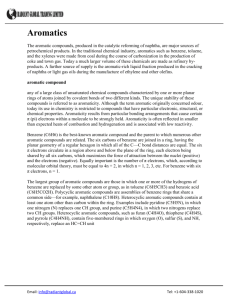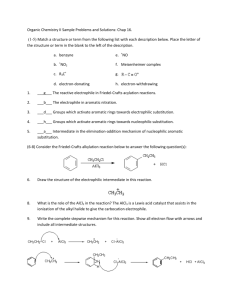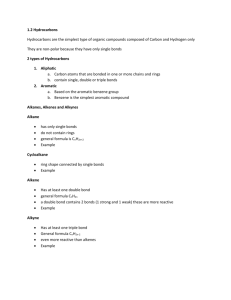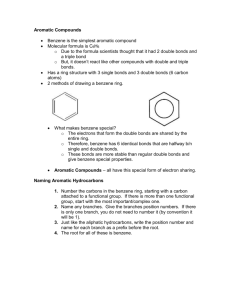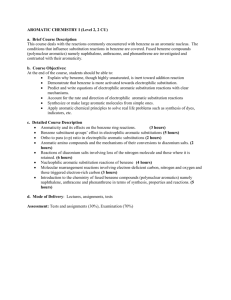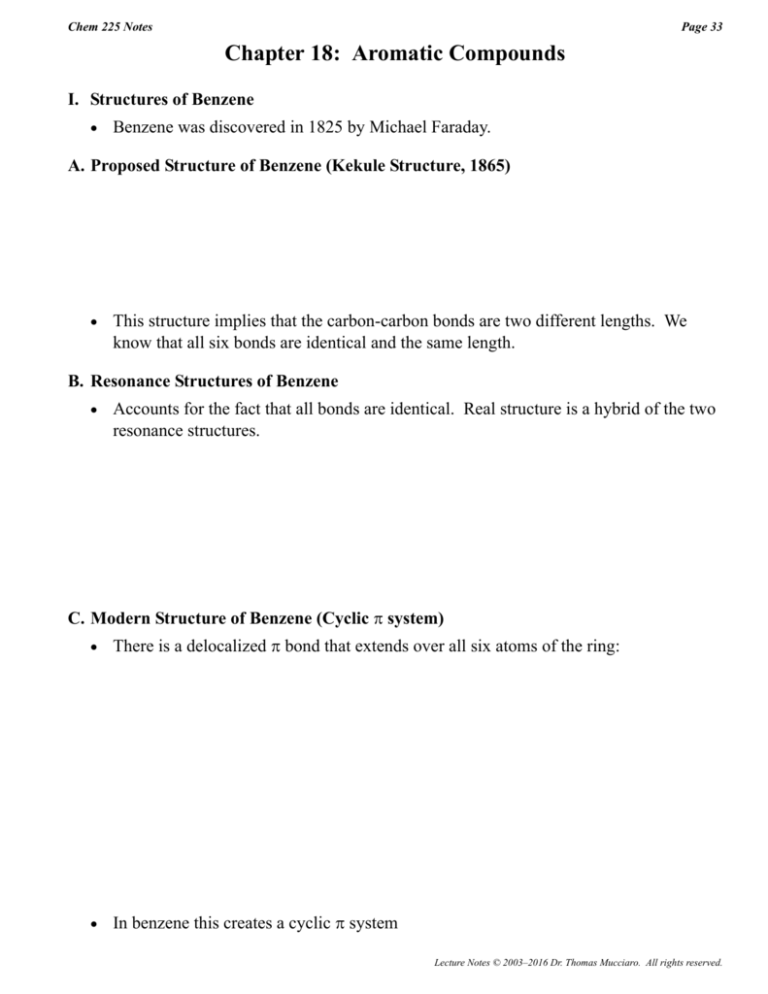
Chem 225 Notes
Page 33
Chapter 18: Aromatic Compounds
I. Structures of Benzene
Benzene was discovered in 1825 by Michael Faraday.
A. Proposed Structure of Benzene (Kekule Structure, 1865)
This structure implies that the carbon-carbon bonds are two different lengths. We
know that all six bonds are identical and the same length.
B. Resonance Structures of Benzene
Accounts for the fact that all bonds are identical. Real structure is a hybrid of the two
resonance structures.
C. Modern Structure of Benzene (Cyclic system)
There is a delocalized bond that extends over all six atoms of the ring:
In benzene this creates a cyclic system
Lecture Notes © 2003–2016 Dr. Thomas Mucciaro. All rights reserved.
Chem 225 Notes
Ch 18 Aromatic Compounds
Page 34
II. Special Properties of Benzene
A. Benzene contains double bonds ( bonds) but does not react like normal alkenes.
“Normal” alkenes react by addition:
Benzene is unreactive under these conditions:
If “forced” to react, benzene will react by substitution, not addition:
B. Benzene is unusually stable (low H of hydrogenation)
benzene is 36 kcal
more stable than
expected.
energy
–57.4
kcal
–28.6
kcal
(–85.8 predicted)
36 kcal
(resonance
energy)
1.8 kcal
more
stable
–55.4
kcal
(actual)
–49.8
kcal
Lecture Notes © 2003–2016 Dr. Thomas Mucciaro. All rights reserved.
Chem 225 Notes
Ch 18 Aromatic Compounds
Page 35
III.Aromaticity: Huckel’s Rules
Aromaticity: compounds with special properties of benzene are called aromatic
compounds.
Initially, it was believed that the alternating pi bonds in the ring (alternating pi bonds is
called conjugation) caused its special properties. Scientists thought that
cyclooctatetraene would also be aromatic. When it was synthesized, it was found to
react like normal alkenes, and was not aromatic.
Huckel’s Rules: A compound will be aromatic if it has all the following properties:
1. it is planar and cyclic;
2. it has a cyclic system ( bond, lone pair or empty p orbital an every atom of ring);
3. it has 4n+2 electrons in the cyclic system (4n+2 rule).
If a compound does not satisfy rule 1 or 2, it is not aromatic.
Lecture Notes © 2003–2016 Dr. Thomas Mucciaro. All rights reserved.
Chem 225 Notes
Ch 18 Aromatic Compounds
Page 36
If a compound satisfies rules 1 and 2, but has 4n electrons, it is anti-aromatic and is
extra unstable
A given atom may only donate one pair of electrons to the cylic system. If an atom
has two lone pairs, only one will count. If an atom has a bond and a lone pair, only
the bond will usually be counted. It can help to draw a picture of the cylic system.
Lecture Notes © 2003–2016 Dr. Thomas Mucciaro. All rights reserved.
Chem 225 Notes
Ch 18 Aromatic Compounds
Page 37
IV.Molecular Orbitals of Cyclic Pi Systems (Frost circles)
The pi molecular orbitals of cyclic systems are more complicated than those of linear
systems. Furthermore, the shape and symmetry of the ring contribute to the structure
of the orbitals.
One method for estimating the energy levels of the cyclic pi orbitals uses polygons
inscribed in a circle. These are called Frost circles.
1) Draw the ring polygon with one vertex at the bottom.
2) Draw a circle around the polygon.
3) The line that cuts horizontally through the circle is the zero energy level.
4) The orbitals will be located energetically at the points where the polygon and circle
intercept. Orbitals below the zero energy are bonding; those above are antibonding.
5) Count the pi electrons and fill the orbitals. If the HOMO’s have closed shells
(completely filled), then the system is aromatic; if not, it is antiaromatic.
Lecture Notes © 2003–2016 Dr. Thomas Mucciaro. All rights reserved.
Chem 225 Notes
Ch 18 Aromatic Compounds
Page 38
V. Nomenclature of Aromatic Compounds
1. Monosubstituted benzenes are named as “substituent benzene.”
CH2CH3
Br
bromobenzene
ethylbenzene
2. Common names of special monosubstituted benzenes (MEMORIZE). These are also
used in the IUPAC system.
O
CH3
OH
toluene
phenol
SO3H
aniline
OCH3
benzenesulfonic acid
C
NH2
CH
anisole
OH
benzoic acid
CH2
styrene
3. Use ortho (1,2); meta (1,3); or para (1,4) to indicate the relative positions of
substituents on disubstituted benzenes. For groups that are part of the special benzenes
(see part 2 above), the special group is at position 1.
CH3
O
C
Cl
Cl
ortho-dichlorobenzene
NO2
meta-nitrotoluene
OH
H2N
para-aminobenzoic acid
Lecture Notes © 2003–2016 Dr. Thomas Mucciaro. All rights reserved.
Chem 225 Notes
Ch 18 Aromatic Compounds
Page 39
4. Use the lowest numbers possible to indicate the positions of substituents on benzenes
with three or more substituents. However, the special groups (from part 2 above) are
always placed at position 1.
CH3
NO2
NO2
OH
Cl
NO2
Br
2,4,6-trinitrotoluene
(CH3 is at carbon 1)
Br
Br
3,5-dibromophenol
(OH is at carbon 1)
CH2CH3
2-bromo-1-chloro-4-ethylbenzene
5. The benzene ring can be named as a phenyl group when attached to complicated
chains.
OH
CH
CH3
1-phenylethanol
6. There are several polycyclic aromatics with common names:
naphthalene
anthracene
Lecture Notes © 2003–2016 Dr. Thomas Mucciaro. All rights reserved.
Chem 225 Notes
Ch 18 Aromatic Compounds
Page 40
VI.Reactions on the Side Chains of Alkyl-Substituted Aromatic Rings
When an alkyl chain is attached to an aromatic ring, it is often called the side chain of
the compound. The aromatic ring can influence the chemistry of the side chain,
especially on the carbon directly attached to the ring.
The an alkyl carbon attached directly to a benzene ring is called a benzylic carbon. It is
in the benzylic position.
A benzyl group consists of a -CH2 group with a phenyl ring attached:
A. Free-Radical Halogenation:
Radicals on benzylic carbons (benzylic radicals) are resonance stabilized, and are more
stable than 3o alkyl or allylic radicals.
Free-radical halogenation with bromine will occur in the benzylic position in
preference to all other possible sites of reactivity:
So the complete order of radical stability is:
Least
Most
OH
PH, vinyl
CH3
1o
2o
3o, 1o allyl
2o allyl
benzyl
120
110-108
104
98
95
91
87
85
Lecture Notes © 2003–2016 Dr. Thomas Mucciaro. All rights reserved.
Chem 225 Notes
Ch 18 Aromatic Compounds
Page 41
B. Oxidation of Side Chains
Observed Reaction:
Example:
Lecture Notes © 2003–2016 Dr. Thomas Mucciaro. All rights reserved.
Chem 225 Notes
Ch 18 Aromatic Compounds
Page 42
C. Vinyl Benzenes
A benzene ring with a double bond directly attached is called a vinyl benzene. The
simplest vinyl benzene is called styrene:
A. Preferential Formation of Vinyl Benzenes
Recall Zaitsev’s Rule: the most substituted double bond is preferred. The underlying
explanation for Zaitsev’s Rule was that the most stable double bond would prefer to be
formed.
Conjugation adds stability to an alkene, especially conjugation with an aromatic ring.
Thus, conjugation will be preferred even when the less substituted product is formed as
a result:
B. Addition to Vinyl Benzenes
Benzylic carbocations also are very strongly stabilized by resonance with the aromatic
ring. This makes them more stable than 3o or allylic carbocations.
Recall Markovnikov’s Rule: In additions of H-Nu pairs to an alkene, the hydrogen will
add to the carbon with the most hydrogens attached.
Lecture Notes © 2003–2016 Dr. Thomas Mucciaro. All rights reserved.
Chem 225 Notes
Ch 18 Aromatic Compounds
Page 43
Markovnikov’s Rule was explained by looking at the carbocation intermediate.
Adding hydrogen to the less substituted carbon creates a carbocation on the more
substituted carbon. This is the more stable carbocation.
Thus, Markovnikov’s Rule is observed because in additions to an alkene, the more
stable carbocation intermediate is preferred to be formed.
When adding to a vinyl benzene, the benzylic carbocation will be the most stable
carbocation, even if it is less substituted than the other carbon. Thus, the preferred
product will always come from the benzylic carbocation, even if this violates
Markovnikov’s Rule.
Lecture Notes © 2003–2016 Dr. Thomas Mucciaro. All rights reserved.





